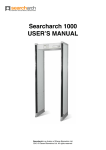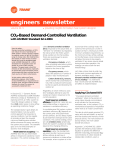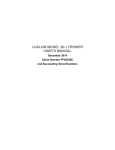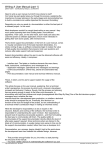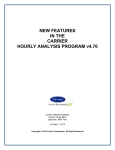Download HAP e-Help - HVACpartners
Transcript
HAP e-Help rev Apr 30, 2014 HAP v4.8 QB TIP 001 Obtaining Consistent Results Using HAP and the ASHRAE 62MZ Ventilation Rate Procedure Spreadsheet Introduction A key task in commercial building HVAC design is determining outdoor ventilation airflow rates. In most jurisdictions in the United States, ventilation airflow rates must comply with local building code requirements, and for many applications those codes typically reference ASHRAE Standard 62.1, Ventilation for Acceptable Indoor Air Quality. Engineers have a number of tools at their disposal to calculate Standard 62.1-required airflows for a building project. One tool is Carrier’s Hourly Analysis Program (HAP), a full service HVAC system design tool in which the ventilation airflow calculation is just one of many design calculations being performed. Another tool is the ASHRAE 62MZ Ventilation Rate Procedure spreadsheet, a tool focused solely on the ventilation airflow calculation. In some projects designers are required to submit ventilation airflow rate calculations using the ASHRAE 62MZ Spreadsheet. This creates a situation where HAP is used to design the full system, and ASHRAE 62MZ is used to submit documentation for the ventilation airflow calculations. Obtaining consistent results between the two tools is critical in these projects. The purpose of this article is to demonstrate how consistent results can be obtained using the Carrier Hourly Analysis Program (HAP) and the ASHRAE 62MZ Ventilation Rate Procedure spreadsheet. Both calculate the ventilation airflow correctly per the Ventilation Rate Procedure in ASHRAE Standard 62.1, Ventilation for Acceptable Indoor Air Quality. After reading this article you should be able to: 1. Determine the system ventilation airflow for an example VAV (variable air volume) system and interpret the results using the HAP Ventilation Sizing Summary report. 2. Reproduce the same results using the ASHRAE 62MZ spreadsheet for the identical VAV system example. 3. List 4 reasons how different results between HAP and 62MZ occur. Carrier's Hourly Analysis Program calculates peak loads and sizing requirements for HVAC systems in commercial buildings. It also offers energy analysis capabilities for comparing energy consumption and operating costs of design alternatives. The ASHRAE 62MZ Ventilation Rate Procedure spreadsheet is used by design engineers to calculate the ventilation air requirements of multiple zone systems such as VAV. However, 62MZ can be also be used for simpler ventilation scenarios like single zone systems and 100% OA systems. Note: Throughout this discussion, the term ventilation air refers to the outdoor air quantity, not the supply air quantity. In addition, note that the term ventilation zone in Standard 62.1 is equivalent to the term space in HAP. The Importance of Correct Ventilation Air Calculation The ventilation airflow at the air system level is used to: 1. Calculate heating and cooling loads to establish the HVAC equipment sizing 2. Perform energy analysis for use in determining final HVAC system choice 3. Comply with local codes which typically reference ASHRAE Standard 62.1 4. Establish the required level of outdoor air that promotes indoor air quality, achieves occupant satisfaction, and increases productivity while maintaining acceptability to green building design practices. Software Support: [email protected] Page 1 More eHelps: Software Support Web Page HAP e-Help rev Apr 30, 2014 HAP v4.8 QB TIP 001 Obtaining Consistent Results Using HAP and the ASHRAE 62MZ Ventilation Rate Procedure Spreadsheet Using the Carrier HAP Program for Ventilation Calculations Carrier’s Hourly Analysis Program (HAP) allows users to determine the minimum system ventilation (outdoor air) requirements per ASHRAE Standard 62.1-2010, 2007, 2004, or 2001. For our example we will choose to follow ASHRAE 62.12010. HAP will ensure each space receives its required ventilation. HAP will automatically evaluate all the different spaces, reliably identify the critical space, and determine the compliant ASHRAE Standard 62.1 ventilation airflow for the air system. Complete background information on the ASHRAE Standard 62.1 Ventilation Rate Procedure along with detailed explanations of the important terms like “critical space” can be found in the eHelp Optimizing Ventilation Design in HAP. For our discussion, we will use an 8-zone VAV system with “shutoff” VAV boxes in each zone. Each box will have a reheat coil with minimum box position at 30% of the peak supply airflow. Procedure for Calculating System Ventilation Air Using HAP Step 1 Assign an ASHRAE Standard 62.1 space type for each space in the system from the Space Usage list under OA Ventilation Requirements. The Space Usage list contains all space usage categories from Table 6-1 in Standard 62.1 and will automatically populate the required CFM/person and CFM/sqft ventilation air requirements when selected from the drop down (Figure 1). The option also exists to “user define” a space type not included in ASHRAE Standard 62.1, and then user define a suitable CFM/person and CFM/sqft OA requirements. Figure 1. Select Space Usage Type Software Support: [email protected] Figure 2. Airflow Control and Ventilation Sizing Method Page 2 More eHelps: Software Support Web Page HAP e-Help rev Apr 30, 2014 HAP v4.8 QB TIP 001 Obtaining Consistent Results Using HAP and the ASHRAE 62MZ Ventilation Rate Procedure Spreadsheet Step 2 Configure the Airflow Control and the Ventilation Sizing Method Here we configure the airflow control and the ventilation sizing method for the HVAC unit (Figure 2). “Constant” airflow control assures the minimum ventilation airflow is maintained at the unit OA intake, even when the VAV supply fan airflow is being reduced because of a reduction in space sensible loads. Select “ASHRAE” for the Ventilation Sizing Method at the air system level since we must comply with the ASHRAE 62.1-2010 multi-space requirement. This input tells HAP to perform the complete Standard 62.1 Ventilation Rate Procedure for the air system. Step 3 Configure the VAV terminal type and the box minimum flow for each zone For our example we will leave “All zones are the same” checked and will select VAV boxes with reheat coils (Figure 3). We will choose to set the minimum airflow at 30%. This means as the cooling load decreases, the box damper closes until it reaches this minimum position. This minimum position sets the zone minimum supply airflow rate which typically will occur during heating operation. Because it is necessary to maintain the minimum outdoor ventilation airflow at all times. HAP will automatically override the user defined box minimum flow if the required ventilation airflow for the zone is larger than the specified minimum flow. Figure 3. Terminal Type and Minimum Airflow Software Support: [email protected] Figure 4. Ventilation Sizing Summary Report Selection Page 3 More eHelps: Software Support Web Page HAP e-Help rev Apr 30, 2014 HAP v4.8 QB TIP 001 Obtaining Consistent Results Using HAP and the ASHRAE 62MZ Ventilation Rate Procedure Spreadsheet Step 4 Calculate design loads and ask for the Ventilation Sizing Summary Select the “Ventilation Sizing Summary” report option (Figure 4). Ventilation Sizing Summary is the design load report which provides the final results of the Standard 62.1 Ventilation Rate Procedure calculation. It lists the sizing method, the design condition and the ventilation airflow rates (both corrected and uncorrected). Step 5 Interpret the Ventilation Sizing Summary Report To fully appreciate the information in the Ventilation Sizing Summary report, we need to make sure the following important concepts are understood (Figure 5). HAP incorporates the necessary ASHRAE calculation steps. The software calculates how much outdoor ventilation air is required at the HVAC system intake to ensure the breathing zone of each space receives its required ventilation. In a multiplezone system almost always the ventilation airflow required at intake is larger than the sum of the uncorrected space airflows. The amount of increase in airflow depends on critical space issues and the air distribution effectiveness of the system and its air terminals. Critical Space involves a concept that meeting the ventilation requirements of the one space in a VAV system that requires the highest ratio of OA to supply air may require over ventilating the other spaces. HAP automatically determines the critical space. It is not necessary for the user to manually identify the critical space ahead of time. The air distribution effectiveness of the air terminal equipment is considered in calculating ventilation requirements. For ceiling supply of cold air, ASHRAE Table 6-2 specifies a value of 1.0. For systems which also deliver warm air from a ceiling supply diffuser, and have supply air 15 F or more above room air temperature, an effectiveness of 0.8 is used. Figure 5. HAP Ventilation Sizing Summary Software Support: [email protected] Page 4 More eHelps: Software Support Web Page HAP e-Help rev Apr 30, 2014 HAP v4.8 QB TIP 001 Obtaining Consistent Results Using HAP and the ASHRAE 62MZ Ventilation Rate Procedure Spreadsheet Both the critical space and air distribution effectiveness considerations are built into a "space ventilation efficiency" value calculated for each space. This critical space ventilation efficiency is used to correct the original uncorrected airflow requirements to obtain the total ventilation airflow required at intake. The critical space is determined by HAP automatically. It is the space with the lowest ventilation efficiency and is shown on the HAP Ventilation Sizing Summary. In our VAV example it was the Lobby space in zone 7. Also included is a calculation from ASHRAE that takes into account an adjustment in ventilation airflow based on the number of people in the space fluctuating over time. This is called Time Averaged Occupancy. HAP retrieves the data it needs from the fractional people schedule. Per Standard 62.1 HAP automatically performs the entire ventilation calculation twice - once for the cooling condition and once for the heating condition. The larger of the two results is displayed in the Ventilation Sizing Summary Report as the required outdoor ventilation airflow for the system. Notice the example Ventilation Sizing Summary says “Design Condition – Minimum Flow Heating.” That means in our example after both calculations were done, the heating condition resulted in the larger ventilation calculation. AHU 1 Results Using HAP Ventilation Sizing Summary Design Ventilation Airflow AHU-1 1307 CFM Critical Space Lobby System Ventilation Efficiency 0.742 Procedure for Calculating System Ventilation Air Using the ASHRAE 62MZ Performance Rating Method Calculator Let’s now enter the same 8 zone VAV system into the ASHRAE 62MZ Ventilation Rate Procedure spreadsheet. The 62MZ spreadsheet comes with a directions tab. If we enter all the zones in the system, then the critical zone will be automatically found. However, both the spreadsheet and the Standard allow the user to enter only those zones that are anticipated to be the critical zones under the operating scenarios to be analyzed. At that point, however, you are depending on your judgment and experience as to whether or not you can accurately eliminate the non-critical zones in order to save data entry time using the spreadsheet. Here is some information taken directly from the 62MZ spreadsheet instructions providing some guidance in selecting zones for analysis. The idea is to not have to enter all the zones if possible. Cooling Condition: For single duct systems, the zones most likely to be critical are those with low cooling loads and high occupancy loads. For example, in office buildings, interior conference rooms are almost always the critical zone. Exterior conference rooms with north exposures or shaded glass are also likely candidates. Zones with high envelope cooling loads (e.g. south and west zones) seldom are critical due to their high supply air rates. Zones with low occupant density are also seldom critical zones. Software Support: [email protected] Page 5 More eHelps: Software Support Web Page HAP e-Help rev Apr 30, 2014 HAP v4.8 QB TIP 001 Obtaining Consistent Results Using HAP and the ASHRAE 62MZ Ventilation Rate Procedure Spreadsheet Heating Condition: For single duct systems, the critical zones are generally perimeter zones with low airflow rates, such as north zones. For VAV systems, look for exterior zones that have low minimum primary supply air rates. For our example, we will play it safe and enter all 8 ventilation zones. We are not sure which of the modes will have the highest ratio of ventilation air to supply air in cooling or heating nor are we confident to manually find the critical zone. Let’s let the 62MZ find the critical zone for us. Note: Standard 62.1 requires calculating ventilation airflow for the system for both cooling mode and heating mode and then taking the larger result. The fastest way to do this is to fill out the spreadsheet first for the cooling mode. Then make a copy of the spreadsheet and modify it for the heating mode. Finally, compare the two results and take the larger result. We already know from using HAP the heating mode resulted in a larger ventilation airflow calculation than the cooling mode. Therefore, for the sake of discussion below, we will concentrate on the heating mode. Keep in mind, if we didn’t already know the results from HAP, we would need to perform both a cooling mode and heating mode 62MZ analysis and pick the larger of the two results. Both the 62.1 Standard and User’s Manual are available at ASHRAE’s online bookstore (ASHRAE.org). Their Ventilation Rate Procedure spreadsheets are packaged with the User’s Manual. Step 1 – Enter Project Information into 62MZ We must decide which mode (cooling or heating) this analysis will involve. As we discussed above we will just perform the peak heating mode calculation in this discussion. Notice also you can add the appropriate number of zones which for our example will be eight. (Figure 6) Figure 6. 62MZ Project Information Step 2 – Enter “Inputs for System” These inputs are related to area, supply airflow, and people count (Figure 7). Figure 7. 62MZ Inputs for System Software Support: [email protected] Page 6 More eHelps: Software Support Web Page HAP e-Help rev Apr 30, 2014 HAP v4.8 QB TIP 001 Obtaining Consistent Results Using HAP and the ASHRAE 62MZ Ventilation Rate Procedure Spreadsheet Enter the total area of 3771 sqft which is the sum of all eight zones. Our total people count is 74 and we will choose to keep the diversity at 100% meaning the occupants are all in the respective zones at the same time. The people count per zone was based on our own observation of job requirements. Both HAP and 62MZ could accommodate a diversity value less than 100% and inputs should match. We also input the overall design primary supply fan airflow rate for AHU 1. In our case, this was generated from the HAP program. Step 3 Enter “Inputs for Potentially Critical Zone” Enter zone by zone inputs related to occupancy category, area, supply airflow, and people count (Figure 8). Figure 8. 62MZ Inputs for Potentially Critical Zone Note that in Standard 62.1 terminology a “ventilation zone” is an occupied HAP space. Therefore to obtain results equivalent to HAP you must enter data for individual HAP spaces, not data for HAP thermostatic zones which can be the collection of multiple spaces. In the subsequent discussion remember that “zone” equals a HAP “space”. The ASHRAE space usage types are built into the 62MZ spreadsheet in a pull-down list. As you enter the category for each zone, the 62MZ spreadsheet will automatically populate the required CFM per person and CFM per sqft ventilation air requirements. Next, the user enters the zone by zone floor area, people count, and zone supply airflow. If the design population of the zone is not input here, 62MZ will default to the number of people calculated using the default occupant density in Table 6-1 of Standard 62.1. For our example, we input our own people count in each zone. The design supply airflow to the zone is input next. For our example, this airflow came from the HAP program. Keep in mind, even though we are analyzing the heating mode in the 62MZ spreadsheet, the “design” airflow to a zone will typically occur at peak cooling conditions. That is the largest airflow that will enter the zone. Later we will tell the 62MZ spreadsheet how much airflow is present in the heating mode. 62MZ will find the critical zone and color it purple. Notice in this case it is the same critical zone (Lobby) as was found by HAP. Software Support: [email protected] Page 7 More eHelps: Software Support Web Page HAP e-Help rev Apr 30, 2014 HAP v4.8 QB TIP 001 Obtaining Consistent Results Using HAP and the ASHRAE 62MZ Ventilation Rate Procedure Spreadsheet Step 4 Enter “Inputs for Operating Condition Analyzed” Here, we enter the percentage of the design supply airflow rate at the conditioned being analyzed. For our example VAV system, this is 30%. (Figure 9) Figure 9. 62MZ “Inputs for Operating Condition Analyzed” Figure 10. Air Distribution Effectiveness Values Next, enter the zone air distribution type. These values are available in 62MZ from a pull-down menu (Figure 10). This value will vary depending in the condition being analyzed. For our example VAV project using a VAV box with overhead supply and return, we will pull down CSCRH (ceiling supply, ceiling return, heating) system. This choice defaults the air distribution effectiveness to 0.8. Note: If we were performing the full analysis including cooling mode, in the cooling mode the “percent of total design airflow rate at condition analyzed” for this VAV system would also be 30%. That is because Standard 62.1 requires the minimum primary supply airflow rate be used (Section 6.2.5.1 Standard 62.1-2010). The “air distribution type” for cooling would be the “CS” option, resulting in an air distribution effectiveness of 1.0. Software Support: [email protected] Page 8 More eHelps: Software Support Web Page HAP e-Help rev Apr 30, 2014 HAP v4.8 QB TIP 001 Obtaining Consistent Results Using HAP and the ASHRAE 62MZ Ventilation Rate Procedure Spreadsheet Step 5 Note the 62MZ Results and Compare to HAP As we can see, we were successful in obtaining identical results using HAP and the ASHRAE 62MZ Ventilation Rate Procedure spreadsheet (Figures 11, 12). The difference of 1 CFM is negligible and attributable to a numerical rounding. Figure 11. 62MZ Results HAP Ventilation Sizing Summary vs ASHRAE 62MZ VRP Spreadsheet HAP Design Ventilation Airflow (AHU-1) 62MZ 1307 CFM 1306 CFM Critical Space Lobby Lobby System Ventilation Efficiency 0.742 .75 OA CFM/person 17.66 17.60 0.35 0.35 OA CFM/sq ft Figure 12 Comparison Results HAP vs 62MZ As we can see, we were successful in obtaining identical results using HAP and the ASHRAE 62MZ Ventilation Rate Procedure spreadsheet. The difference of 1 CFM is negligible and attributable to a numerical rounding. With that in mind, let’s go to our third objective which was to list reasons why different results between HAP and 62MZ may occur. The main reason for any differences may well be from the nature of the 62MZ spreadsheet and of HAP. If the inputs you use are the same in the spreadsheet and in HAP, the results will be the same. But there are pitfalls which can easily result in the inputs being different hence the outputs will be different also. HAP takes care of you. HAP collects the information needed for a 62.1 Ventilation Rate Procedure calculation from the normal information you enter in your project and it calculates for you. (Data like floor area, number of occupants, occupant schedules, system type, supply terminal type, supply airflow rates, minimum terminal settings, etc). It uses this basic data to produce the correct Standard 62.1 required ventilation for your system automatically. It Software Support: [email protected] Page 9 More eHelps: Software Support Web Page HAP e-Help rev Apr 30, 2014 HAP v4.8 QB TIP 001 Obtaining Consistent Results Using HAP and the ASHRAE 62MZ Ventilation Rate Procedure Spreadsheet automatically checks both the cooling condition and the heating condition and reports the larger result. HAP is easy to set up, run the analysis and get reliable results. The 62MZ will take care of you also. But you must be sure to use it correctly. The 62MZ Ventilation Rate Procedure spreadsheet is fairly complex, so there is a chance of input errors or misunderstandings about what the spreadsheet wants. Also you have to recognize that when using the 62MZ spreadsheet, two spreadsheet calculations with different inputs (cooling mode first and then heating mode) are usually necessary to arrive at the final result. Additional Factors to Consider to Achieve the Same Results: 1. Occupant schedules – If they are set to 100% all the time, then determining the design population is straightforward. If you have a varying hour by hour schedule for occupants, then it is not. HAP automatically calculates time-averaged occupancy allowed by Standard 62.1 and lists this on the Ventilation Sizing Summary. These values should be used in the spreadsheet. If you instead use the design occupant value from your HAP space inputs (ignoring time averaged occupancy), you will get different results. If you attempt to calculate time-averaged occupancy by hand, it is a multistep procedure for each space. 2. Design supply airflow – You need to make sure you use the values from the individual spaces table on the Zone Sizing Summary from HAP (or other design software). In cases where a space is critical to the extent it requires 100% OA, the 62MZ spreadsheet requires you to manually adjust the supply airflow up 1 or 2 CFM manually. Note that the HAP results have already adjusted the supply airflow rates for cases where OA requirement is greater CFM required by peak sensible load. If you use airflow data from a source other than HAP it may not have that correction applied and that will lead to different results. 3. The 62MZ spreadsheet, like the 62.1 Standard, encourages you to only analyze zones that are likely to be critical spaces. It is often difficult to predict which space will be critical or not. HAP automatically analyzes all your spaces and determines the critical one. If you omit the space that is actually critical, that can result in different results between HAP and spreadsheet. 4. Diversity Factor – Diversity has a very specific definition for Standard 62.1, and is shown in Appendix A of the standard. HAP calculates the diversity if there is any. If you calculate this by hand, it requires knowing the timeaveraged peak occupancy in all the individual spaces and the peak coincident occupancy of all spaces in the system together. If varying hour by hour schedules are used (rather than 100% all hours), it takes some manual effort to get the data to make this calculation correct. 5. Whole Numbers and Round Off –Small differences in results between HAP and the spreadsheet (on the order of 5 to 20 CFM in total system airflow) are often due to the fact the spreadsheet accepts whole number inputs and HAP is calculating the full number. That difference ultimately causes small differences in the result like those in our example. Conclusion: When comparing results from different tools such as HAP and 62MZ, a user must be proficient with the operation of both tools in order to obtain correct, consistent results. Otherwise the risk is high there will be differences in inputs and those will cause different results. The nature of the Ventilation Rate Procedure is quite complex with many formulas. It lends itself to being done with a tool that is capable of analyzing multiple scenarios simultaneously. Software Support: [email protected] Page 10 More eHelps: Software Support Web Page












